The Kerala High Court stressed that the state must promptly take legal action against those responsible for two recent mishaps near the coast of Kerala involving the ships, MSC ELSA-3 and WAN HAI 503.
Published Jul 08, 2025 | 11:00 AM ⚊ Updated Jul 08, 2025 | 11:21 AM
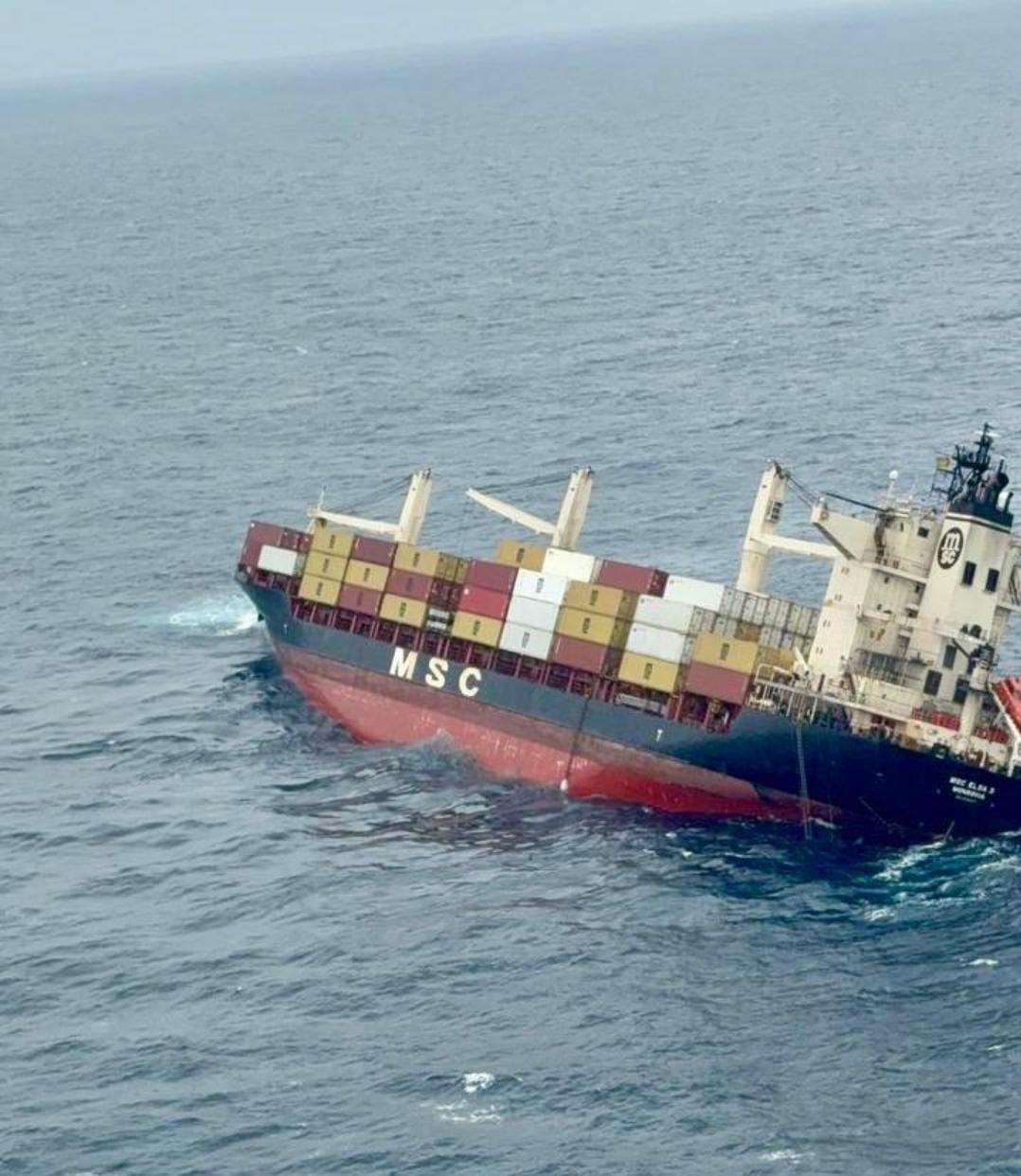
MSC ELSA 3 before sinking.
Synopsis: A massive shoreline cleanup operation is underway along the southern coast, from Thiruvananthapuram to Rameshwaram and Kanniyakumari, following the plastic pellet (nurdle) spill from the ill-fated MSC ELSA 3.
It’s been over a month since the container ship MSC ELSA 3 sank off the Kerala coast. Soon after, another vessel, Wan Hai 503, caught fire off the state’s coast.
The waves of uncertainty these two maritime incidents have unleashed still ripple across the state’s shores.
From toxic cargo concerns and missing crew members to the painstaking salvage operations and lingering ecological fears, these two disasters have left behind more than wreckage: They’ve exposed a fragile marine ecosystem and a community of fisherfolk trapped in limbo.
As Kerala waits for clarity, what lies beneath the waterline remains a growing worry.

Plastic nurdles collected from coastal stretch at Thiruvananthapuram
Over a month after the MSC ELSA 3 sank off the Alappuzha coast, salvage and environmental response efforts remain in full swing. The state government has estimated that shipwreck has caused a loss of ₹9,531 crore, mainly due to the severe marine pollution, besides affecting livelihoods.
The Panama-flagged vessel, operated by MSC Shipmanagement Ltd., developed a severe starboard list while sailing from Vizhinjam to Kochi and went down into the sea about 13 nautical miles off the coast on 25 May.
Since then, all deck containers, including 13 carrying hazardous Calcium Carbide — a chemical that reacts dangerously with water — were reported adrift.
But other than that, another major area of concern is the massive nurdle spill.
Officials stated that a massive shoreline cleanup operation is underway along the southern coast, from Thiruvananthapuram to Rameshwaram and Kanniyakumari, following the plastic pellet (nurdle) spill from the ill-fated MSC ELSA 3.
So far, authorities have recovered nearly 600 tonnes of nurdles — approximately 350 tonnes in Kollam and Trivandrum, 200 tonnes in Rameshwaram, and 50 tonnes in Kanniyakumari.
However, according to cargo manifests, MSC ELSA 3 was carrying 72 containers of plastic nurdles, weighing 1,559 metric tonnes, that is 71,540 pellet bags.
Of these, only eight containers — containing 7,920 pellet bags — were recovered from the Kerala shoreline.
With nurdles continue to wash ashore, posing a serious threat to marine life, fishing livelihoods, and coastal ecosystems, the fisher community’s concerns are many.
Recovered nurdles in Kerala are being secured at Kollam Port under bonded storage, while Tamil Nadu has stockpiled the material at designated sites pending disposal directions.
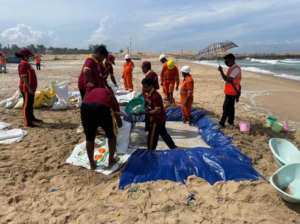
Volunteers engaged in collection of plastic nurdles
Meanwhile, the Directorate General of Shipping confirmed that a comprehensive disposal plan for recovered nurdles remains pending (as of 5 July), with coordination required between Marine Emergency Response Centre (MERC), Clean Kerala, MSC, and statutory authorities to ensure environmental compliance and safe handling.
The DGS also noted that some nurdles washing ashore may still be remnants from the initial spill, highlighting the need for sustained shoreline surveillance and recovery efforts.
It’s learnt that the disposal protocols are being finalised in consultation with Customs and environmental agencies.
With only a fraction of the total cargo accounted for, concerns remain high over the fate of the remaining containers, as environmentalists warn of long-term ecological consequences along India’s southern coastline.
Meanwhile, the fishermen said that the plastic nurdles pose a direct threat to marine life, particularly fish and shellfish that mistake the pellets for food. They fear contamination of their catch, which could impact both the safety and marketability of seafood.
Though a seasonal monsoon-time trawling ban is in effect in the state, several fishing harbours have reported nurdles getting trapped in nets and fishing gear, causing operational difficulties and added costs for cleaning and maintenance.
There’s growing anxiety about long-term ecological damage, which could affect fish breeding grounds and disrupt traditional fishing zones.
With uncertainty over how much of the nurdle cargo remains at sea, coastal communities worry about the sustainability of their livelihoods. They have demanded regular clean-up reviews, and scientific studies to assess environmental and health impacts.
According to the information available with the Directorate General of Shipping (DGS), as of 2 July, salvage coordination has been steady, with 24/7 caretaking by the vessel Canara Megh.
It said that no new oil sheens have been sighted, and aerial and on-site surveillance report no major environmental threats.
Water quality monitoring, with over 20 samples tested since May 26, has so far shown normal results.
A Dutch firm, SMIT Salvage, is readying its Dive Support Vessel (DSV) in Singapore, with diving operations expected to commence soon.
As per the information shared by the DGS, the DSV’s departure is set for 24 July and site arrival by 1 August.
“Diving operations are planned to commence immediately upon its arrival. Divers’ visa processing and induction formalities are also ongoing with necessary support sought from the DGS to expedite clearances,” a Kerala Maritime Board source said.
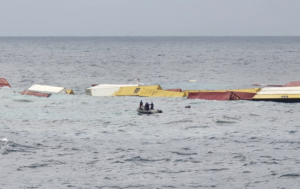
Containers from MSC ELSA 3 floated in the sea
As per the situation report given by the stakeholders to the DGS, efforts are focused on recovering the last three containers and safely handling collected nurdles.
It is learnt that a full legal and technical review is underway regarding hazardous cargo allegations and possible misdeclaration concerns.
Meanwhile, the DGS has emphasised the need for immediate verification of shipper documentation, including bills of lading, packaging details, and multimodal transport declarations to identify any discrepancies.
Investigations are also being initiated following complaints from fishermen about containers affecting fishing nets.
However, authorities also stated that continued vigilance around the site is essential, including routine water sampling, particularly in ecologically sensitive regions like the Gulf of Mannar.
It also added that hourly VHF broadcasts continue, warning passing ships to maintain a one nautical mile exclusion zone around the wreck site.
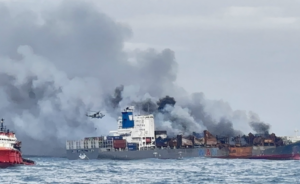
Wan Hai 503
Singapore-flagged container vessel Wan Hai 503, which experienced a major onboard fire following a container explosion on 9 June while en route to Nhava Sheva, remains stranded outside the Indian Exclusive Economic Zone (EEZ).
The vessel continues to be held in position by the tug, Offshore Warrior, as firefighting and salvage operations struggle against rough seas and hazardous conditions.
According to maritime sources, light grey smoke continues to billow from Bay 29 to 35 of the ship, indicating smouldering in cargo hold no. 4 — the epicentre of the fire.
Recent temperature surveys revealed readings as high as 92°C in the hold.
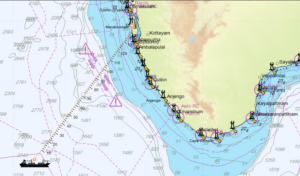
Current position of Wan Hai 503
As per a communication to the DGS, as of 4 July, efforts to deploy the fire-suppressant Pyrocool were aborted due to high winds and unstable deck conditions, complicating containment measures.
The salvage team is also preparing for increased Pyrocool deployment, with logistics
in place to mobilize 15,000 litres of additional supply from Singapore if required.
Meanwhile, salvage teams have boarded the vessel intermittently when weather allows, carrying out structural assessments, temperature monitoring, and searches for missing crew members. No trace has been found so far.
The salvage team currently consists of five firefighters and five salvors.

Dewatering operations in the engine room were temporarily suspended due to a malfunction in the essential power pack for the pump system.
While earlier dewatering efforts had shown positive signs, with a noticeable increase in the stern draft, ongoing tunnel connections between cargo holds and the engine room continue to threaten the vessel’s stability.
The Indian Coast Guard has raised concerns over these challenges, urging a relocation of the vessel to a safer standoff position.
Meanwhile, KMB officials indicates that the situation demands operational patience, with timelines contingent on prevailing fire conditions and vessel stabilization.
They also added that efforts are being made to maintain the current position, balancing logistical access, safety, and proximity to support assets.
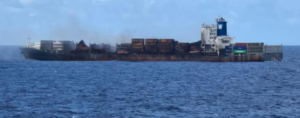
Wan Hai 503 as on 5 July
The vessel is reportedly carrying 157 containers of dangerous cargo classified by the International Maritime Organization (IMO), including flammable materials, spontaneously combustible substances, and toxic chemicals like pesticides.
The risk of environmental contamination in the Arabian Sea remains a serious concern.
Given the uncertainty over port entry clearance, Indian authorities have proposed repositioning the vessel towards the India–Sri Lanka–Maldives tri-junction.
Final decisions are awaited even as salvage teams work round the clock to prevent escalation of the maritime emergency.
Though two maritime incidents occurred, the state government is mostly worried on the potentially serious environmental, social, and economic threats posed by the MSC ELSA 3.
Considering the seriousness of the situation, the state government, on 29 May, officially declared the incident a State-Specific Disaster.
To effectively manage the crisis, a two-tier institutional mechanism was also constituted.
At the state level, an eight-member committee chaired by the Science & Technology Department Secretary will oversee pollution control strategies, resource mobilization, and ecological restoration efforts.
A district-level committee, led by the respective District Collector, will carry out on-the-spot operations — removing debris, salvaging containers, and mitigating contamination risks along the coast.
The government has also appointed the Science and Technology Secretary as Principal Advisor to the Environment Department, with disaster management experts onboard for technical guidance.
In parallel, a high-level negotiation committee, chaired by the Additional Chief Secretary (Finance) with the Law Secretary as Co-chairperson, will engage with the ship’s owners, while the Environment Department moves to file legal proceedings under the Admiralty Act, 2017, positioning itself as the nodal agency for all procedural and legal actions linked to the incident.
According to officials of the Kerala Maritime Board, each department is engaged in actions and impact study being undertaken by agencies like the National Institute of Oceanography, Kochi, is also being planned.
Earlier, the Kerala High Court stressed that the state must promptly take legal action against those responsible for two recent mishaps near the coast of Kerala involving the ships, MSC ELSA-3 and WAN HAI 503.
“Loss of fish, pollution and economic loss have to be considered. You need not spend public exchequer money, recover it from the company,” the court observed then.
With mounting allegations that the state government is going soft on recent shipwreck incidents off the coast, fisherfolk and environmentalists are staring into a sea of uncertainty — and a tide of unanswered questions.
At the heart of the concern is whether the twin mishaps will leave a lasting scar on the fragile marine ecosystem.
For the fishing community, the worry runs deeper.
As the 52-day trawling ban nears its end on 31 July midnight, they fear the incidents might cast a shadow over fish safety and consumer confidence, just as the crucial fishing season is about to resume.
Will the shipwrecks alter fish patterns? Could contamination deter people from buying seafood? And is enough being done to assess the ecological fallout?
These are the questions haunting Kerala’s coastal belt, even as the authorities remain tight-lipped.
The Kerala government, on Monday, 7 July, filed an admiralty suit in the High Court against the vessel MSC Akiteta-2, owned by MSC Shipping Company, demanding ₹9,531 crore as compensation for severe marine pollution and livelihood losses following the sinking of MSC Elsa-3 off the Alappuzha coast on 25 May.
Acting on the petition, a Bench led by Justice MA Abdul Hakim ordered the interim arrest of MSC Akiteta-2, currently docked at Vizhinjam port, until 10 July.
It’s learnt that the state government submitted that the vessel’s sinking caused extensive environmental, ecological, and economic damage.
The government also cited the crash of the fisheries market over contamination fears, and the recent discovery of six carcasses, including dolphins and a whale, suspected to have died from exposure to microplastics and toxic waste.
The claim includes ₹8,626 crore for pollution damages, ₹378 crore for environmental restoration, and ₹526 crore for fisherfolk’s losses.
(Edited by Majnu Babu).

